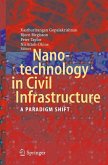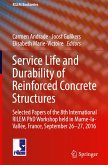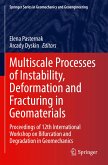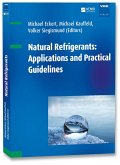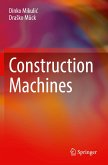Performance and Durability of Composites
Proceedings of the American Society for Composites 39th Technical Conference, Volume 2
Herausgegeben:Sockalingam, Subramani; Koohbor, Behrad; Diaz-Montiel, Paulina
Performance and Durability of Composites
Proceedings of the American Society for Composites 39th Technical Conference, Volume 2
Herausgegeben:Sockalingam, Subramani; Koohbor, Behrad; Diaz-Montiel, Paulina
- Gebundenes Buch
- Merkliste
- Auf die Merkliste
- Bewerten Bewerten
- Teilen
- Produkt teilen
- Produkterinnerung
- Produkterinnerung
This book presents the proceedings of the American Society for Composites 39th Technical Conference. This volume, the second of six volumes, brings together contributions to this important area of research and engineering. The collection presents early findings and studies on fundamental and applied aspects of the performance and durability of composite materials. The volume covers novel computational methods, advances in micromechanics, damage and durability evaluation, and multiscale failure simulations.
Andere Kunden interessierten sich auch für
![Nanotechnology in Civil Infrastructure Nanotechnology in Civil Infrastructure]() Nanotechnology in Civil Infrastructure77,99 €
Nanotechnology in Civil Infrastructure77,99 €![Construction Machines Construction Machines]() Dinko MikulicConstruction Machines106,99 €
Dinko MikulicConstruction Machines106,99 €![Service Life and Durability of Reinforced Concrete Structures Service Life and Durability of Reinforced Concrete Structures]() Service Life and Durability of Reinforced Concrete Structures113,99 €
Service Life and Durability of Reinforced Concrete Structures113,99 €![Multiscale Processes of Instability, Deformation and Fracturing in Geomaterials Multiscale Processes of Instability, Deformation and Fracturing in Geomaterials]() Multiscale Processes of Instability, Deformation and Fracturing in Geomaterials166,99 €
Multiscale Processes of Instability, Deformation and Fracturing in Geomaterials166,99 €![Multiscale Processes of Instability, Deformation and Fracturing in Geomaterials Multiscale Processes of Instability, Deformation and Fracturing in Geomaterials]() Multiscale Processes of Instability, Deformation and Fracturing in Geomaterials166,99 €
Multiscale Processes of Instability, Deformation and Fracturing in Geomaterials166,99 €![Natural Refrigerants: Applications and Practical Guidelines Natural Refrigerants: Applications and Practical Guidelines]() Natural Refrigerants: Applications and Practical Guidelines59,00 €
Natural Refrigerants: Applications and Practical Guidelines59,00 €![Construction Machines Construction Machines]() Dinko MikulicConstruction Machines76,99 €
Dinko MikulicConstruction Machines76,99 €-
-
-
This book presents the proceedings of the American Society for Composites 39th Technical Conference. This volume, the second of six volumes, brings together contributions to this important area of research and engineering. The collection presents early findings and studies on fundamental and applied aspects of the performance and durability of composite materials. The volume covers novel computational methods, advances in micromechanics, damage and durability evaluation, and multiscale failure simulations.
Produktdetails
- Produktdetails
- Proceedings of the American Society for Composites Annual Technical Conferences
- Verlag: Springer / Springer Nature Switzerland / Springer, Berlin
- Artikelnr. des Verlages: 89552426, 978-3-032-05207-0
- Seitenzahl: 352
- Erscheinungstermin: 17. Dezember 2025
- Englisch
- Abmessung: 235mm x 155mm
- ISBN-13: 9783032052070
- ISBN-10: 3032052076
- Artikelnr.: 75134776
- Herstellerkennzeichnung
- Springer-Verlag GmbH
- Tiergartenstr. 17
- 69121 Heidelberg
- ProductSafety@springernature.com
- Proceedings of the American Society for Composites Annual Technical Conferences
- Verlag: Springer / Springer Nature Switzerland / Springer, Berlin
- Artikelnr. des Verlages: 89552426, 978-3-032-05207-0
- Seitenzahl: 352
- Erscheinungstermin: 17. Dezember 2025
- Englisch
- Abmessung: 235mm x 155mm
- ISBN-13: 9783032052070
- ISBN-10: 3032052076
- Artikelnr.: 75134776
- Herstellerkennzeichnung
- Springer-Verlag GmbH
- Tiergartenstr. 17
- 69121 Heidelberg
- ProductSafety@springernature.com
Subramani "Mani" Sockalingam is an Associate Professor in Mechanical Engineering at the University of South Carolina (USC). Dr. Sockalingam received his PhD from the University of Delaware Center for Composite Materials and Master's from the University of Cincinnati, both in Mechanical Engineering. Additionally, he has six years of industrial experience in the automotive and defense sectors. His technical interests include the dynamic behavior of composite materials, inverse methodologies for high throughput material characterization, novel architectured composite material designs for enhancing structural performance, test methods for evaluating high strain rate delamination, and automated fiber placement manufacturing. Behrad Koohbor is an Assistant Professor of Mechanical Engineering at Rowan University. Dr. Koohbor received his PhD from the University of South Carolina. Before joining Rowan University in 2019, Dr. Koohbor completed a 2-year postdoctoral fellowship at the University of Illinois at Urbana-Champaign. Dr. Koohbor is interested in understanding the process-structure-property-performance relations in advanced materials and structures. His team uses various measurement techniques to explore the origins of temperature-dependent and rate-sensitive responses of advanced materials and structures at multiple lengths and time scales. He has been a member of ASC since 2015. Paulina Díaz-Montiel, PhD, is an assistant professor of mechanical engineering at the University of San Diego. Dr. Díaz-Montiel's expertise is in structural mechanics and composite materials. Her work combines manufacturing, testing, experimental mechanics, and computational methods for studying the progressive failure of materials and structures at different scales and loading conditions.
Part 1: Analysis & Testing.- Chapter 1: A Study on Theoretical Analysis Method of Sandwich SCB Test Including Geometric Nonlinearity.- Chapter 2: Damage Evolution of Postbuckled Composite Single-Stringer Panels Subject to Compression After Impact.- Chapter 3: Determination of Mode I Interlaminar Fracture Energy and Cohesive Zone Modelling Parameters in Carbon/Epoxy Composites.- Chapter 4: Evaluating Process-Induced Residual Strains in Multi-Material Single-Lap Joints Using an Experimental Approach.- Chapter 5: Heat Damage Modeling and Simulation of Polymer Composite Structures.- Chapter 6: Matrix Crack Propagation Behavior of Cross-Ply CFRP Laminates at Cryogenic Temperature.- Chapter 7: On the Applicability of Transverse Loading Experimental Method for Determining Tensile Strength of Single Carbon Fibers at Microscale Gage-Lengths.- Chapter 8: Piezoresistivity Analysis of Polymer Composite Piezoresistors and Validation via Monte Carlo Simulations.- Chapter 9: Point Cloud Failure Criterion for Orthotropic Composite Materials.- Chapter 10: Shell-Type Element for Composite Bonded Joint Design.- Chapter 11: Solving the Internal Strain Field in 3D Random Short Fiber Composites Using Known Surface Strains.- Part 2: Composite Pressure Vessels.- Chapter 12: Progressive Damage Analysis of CFRP Pressure Vessels with Dome/Cylinder Bonded Structure.- Part 3: Damage Tolerance and Durability of Material Systems.- Chapter 13: Correlating Microscale Damage with Dielectric State Variable Characterized by Broadband Dielectric Spectroscopy (BbDS).- Chapter 14: Development of a Higher-Level Building Block Testing Standard Using Seven Point Bend Configuration for Performance Evaluation at Scale.- Chapter 15: Progressive Damage Analysis of Complex 3D Textile Based Composite Parts Using Discrete Damage Modeling and Independent Mesh Method.- Chapter 16: Tension-Tension Fatigue Behavior of Carbon/Epoxy Composites with Carbon Nanotube Interlayers.- Chapter 17: Unsupervised Learning of Damage Modes During Fatigue of Composites.- Part 4: Failure Simulation - Multiscale.- Chapter 18: Compressive Strength Prediction of Carbon Fiber/Polyimide Composite at Elevated Temperature Using Micro/Meso-Scale Numerical Simulation Results.- Chapter 19: Image-Based Failure Assessment of Li-Ion Batteries.- Chapter 20: Molecular Dynamics Prediction of Strain Rate-Induced Failure Mode Transitions in Crystalline Polyethylene.- Chapter 21: Toward Realistic Simulation of Transient Events within an Efficient Workflow Using Implicit and Explicit Solvers: Application to Laminated Composite Materials.- Chapter 22: Transfer Learning for Multiscale Analysis: Modeling Delamination of Carbon-Reinforced Composite Material.- Part 5: Fatigue Failure in Composites.- Chapter 23: Damage Mechanisms in Chopped Strand Mat and Woven Roving Mat Composites Subjected to Tension-Tension, Compression-Compression and Tension-Compression Cyclic Loads.- Chapter 24: Investigating the Significance of the R-Curve in Interlaminar Crack Growth of Composites Subjected to Fatigue Loading.- Part 6: Micromechanics.- Chapter 25: Analysis of Anisotropic Inclusion Problems Using Complex Variables.- Chapter 26: Investigating Effects of Oxidation of Graphene Quantum-Dot in Epoxy Composites ñ a Molecular Dynamics Study.- Chapter 27: Peridynamic Simulations of Damage Initiation and Propagation of Microstructural Experiments.- Chapter 28: Use of Convolutional Neural Networks for Microscale Simulations in Progressive Damage Analysis in Composites.
Part 1: Analysis & Testing.- Chapter 1: A Study on Theoretical Analysis Method of Sandwich SCB Test Including Geometric Nonlinearity.- Chapter 2: Damage Evolution of Postbuckled Composite Single-Stringer Panels Subject to Compression After Impact.- Chapter 3: Determination of Mode I Interlaminar Fracture Energy and Cohesive Zone Modelling Parameters in Carbon/Epoxy Composites.- Chapter 4: Evaluating Process-Induced Residual Strains in Multi-Material Single-Lap Joints Using an Experimental Approach.- Chapter 5: Heat Damage Modeling and Simulation of Polymer Composite Structures.- Chapter 6: Matrix Crack Propagation Behavior of Cross-Ply CFRP Laminates at Cryogenic Temperature.- Chapter 7: On the Applicability of Transverse Loading Experimental Method for Determining Tensile Strength of Single Carbon Fibers at Microscale Gage-Lengths.- Chapter 8: Piezoresistivity Analysis of Polymer Composite Piezoresistors and Validation via Monte Carlo Simulations.- Chapter 9: Point Cloud Failure Criterion for Orthotropic Composite Materials.- Chapter 10: Shell-Type Element for Composite Bonded Joint Design.- Chapter 11: Solving the Internal Strain Field in 3D Random Short Fiber Composites Using Known Surface Strains.- Part 2: Composite Pressure Vessels.- Chapter 12: Progressive Damage Analysis of CFRP Pressure Vessels with Dome/Cylinder Bonded Structure.- Part 3: Damage Tolerance and Durability of Material Systems.- Chapter 13: Correlating Microscale Damage with Dielectric State Variable Characterized by Broadband Dielectric Spectroscopy (BbDS).- Chapter 14: Development of a Higher-Level Building Block Testing Standard Using Seven Point Bend Configuration for Performance Evaluation at Scale.- Chapter 15: Progressive Damage Analysis of Complex 3D Textile Based Composite Parts Using Discrete Damage Modeling and Independent Mesh Method.- Chapter 16: Tension-Tension Fatigue Behavior of Carbon/Epoxy Composites with Carbon Nanotube Interlayers.- Chapter 17: Unsupervised Learning of Damage Modes During Fatigue of Composites.- Part 4: Failure Simulation - Multiscale.- Chapter 18: Compressive Strength Prediction of Carbon Fiber/Polyimide Composite at Elevated Temperature Using Micro/Meso-Scale Numerical Simulation Results.- Chapter 19: Image-Based Failure Assessment of Li-Ion Batteries.- Chapter 20: Molecular Dynamics Prediction of Strain Rate-Induced Failure Mode Transitions in Crystalline Polyethylene.- Chapter 21: Toward Realistic Simulation of Transient Events within an Efficient Workflow Using Implicit and Explicit Solvers: Application to Laminated Composite Materials.- Chapter 22: Transfer Learning for Multiscale Analysis: Modeling Delamination of Carbon-Reinforced Composite Material.- Part 5: Fatigue Failure in Composites.- Chapter 23: Damage Mechanisms in Chopped Strand Mat and Woven Roving Mat Composites Subjected to Tension-Tension, Compression-Compression and Tension-Compression Cyclic Loads.- Chapter 24: Investigating the Significance of the R-Curve in Interlaminar Crack Growth of Composites Subjected to Fatigue Loading.- Part 6: Micromechanics.- Chapter 25: Analysis of Anisotropic Inclusion Problems Using Complex Variables.- Chapter 26: Investigating Effects of Oxidation of Graphene Quantum-Dot in Epoxy Composites ñ a Molecular Dynamics Study.- Chapter 27: Peridynamic Simulations of Damage Initiation and Propagation of Microstructural Experiments.- Chapter 28: Use of Convolutional Neural Networks for Microscale Simulations in Progressive Damage Analysis in Composites.


